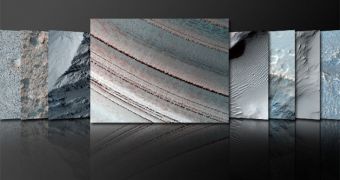Scientists at the NASA Jet Propulsion Laboratory (JPL), in Pasadena, California, announce the release of the first batch of images that the Mars Reconnaissance Orbiter (MRO) snapped at the request of the public. Some time ago, NASA opened channels through which people could select the areas of the Red Planet they wanted to see in most detail. The most popular regions were then investigated by the MRO, and the new 8 images produced by the High Resolution Imaging Science Experiment, or HiRISE camera, are now available here.
The HiWish program, which aimed at getting the general public more interested in Mars, began this January, and has thus far received in excess of 1,000 suggestions, covering a vast array of known, or yet-unobserved, features on the Red Planet. “NASA's Mars program is a prime example of what we call participatory exploration. To allow the public to aim a camera at a specific site on a distant world is an invaluable teaching tool that can help educate and inspire our youth to pursue careers in science, technology, engineering and math,” said of the achievement Charles Bolden, the NASA Administrator.
As we were telling you recently, the MRO has achieved the 100-terabytes of sent data threshold, which makes it the most prolific space mission around Mars and one of the top initiatives ever to have been devised for space exploration. The HiRISE itself has so far sent back in excess of 13,000 images of the Martian surface, since the MRO achieved orbital insertion more than 4 years ago. A number of these photos were snapped as part of the student-suggestion program called NASA Quest. Despite this extraordinary achievement, only about 1 percent of the surface of Mars has been imaged, experts say.
“What we hope is that people become more interested in science and appreciate this opportunity to explore another world. We appreciate fresh thinking outside the box and look for things we may not have chosen otherwise. It's good to have a lot of eyes on Mars,” says University of Arizona in Tucson expert Alfred McEwen, who is the principal investigator for the HiRISE instrument. In addition to the MRO, NASA also operated the Mars Odyssey orbiter, which has participated in a public-choice photography session in 2009 as well. It has been orbiting the Red Planet since 2001.

 14 DAY TRIAL //
14 DAY TRIAL //